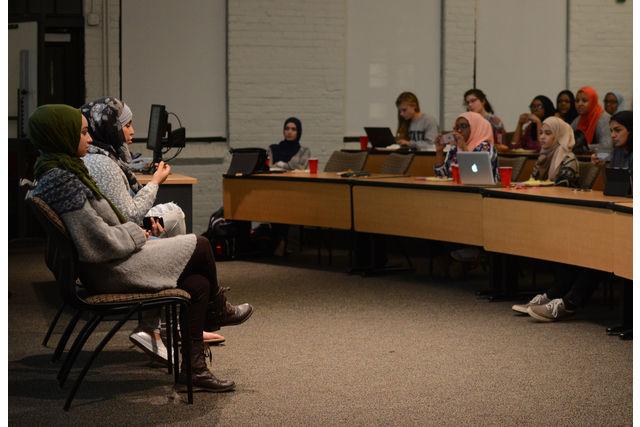Three student panelists in hijab spoke Monday at Beyond the Veil, an event co-sponsored by NC State’s Muslim Student Association and the Women’s Center that gave women who wear the hijab the opportunity to share their experiences and answer questions. The event was an extension of World Hijab Day and served to create dialogue promoting women’s positive personal experiences with the hijab.
“People see a veil, the hijab, but people don’t understand why we wear it,” said Doha Medani, a sophomore studying nutrition science. “There’s so much diversity in the people who wear hijab, different situations in our lives that have brought us to wear it.”
World Hijab Day was created in 2013 by a hijabi, Nazma Khan, as a call to all women. A resident of New York, she founded the day with hopes for a change in the hijab’s perception, inviting all women regardless of religious affiliation to wear the hijab for a day.
“It’s like a ‘walk in a day in their shoes’ type of thing, for women to wear the hijab and see what happens, how things around them change when they are viewed as a Muslim woman — to step into that and get that perspective. So you can empathize in a way, or just better understand it,” said Hoda Abrahim, a senior studying nutrition sciences at North Carolina Central University.
Though often denoted as a sign of oppression, the hijab has a complex, multifarious identity that’s impossible to pin down.
“It is much more complicated than portrayed in the media,” said Jen’nan Read, associate professor at Duke University and recent speaker at an event about Islam and immigration. “Particularly in the West and other countries that do not require women to wear the hijab.”
Though worn by many as a comfort, an identity, an outward sign of faith, the hijab is constricted by social stigmas that reduce its personal, cultural and religious importance. World Hijab Day seeks to change this and highlight the right of a woman’s choice whether or not she dons the traditional headscarf.
“My hijab is how I represent myself to the world: as a Muslim, first and foremost,” Medani said. “The first thing people see … is my hijab. It makes it clear to the world, or whoever else, that I’m Muslim. And with being Muslim comes a certain set of values … it tells people a lot about who you are.”
Abrahim said her hijab is a symbol of her faith.
“I’m wearing my faith on my sleeve,” she said.
Beyond the goal to help redefine the hijab rests a possibly deeper issue: the associated abuse of hijabi women. The hijab is inherently linked with Islam, and as such, clearly identifies Muslim women. Muslim men are innately harder to identify.
“Especially now, because beards are like a hipster thing,” Abrahim said. “For me, if I wasn’t wearing the hijab, you’d have no idea who I was, where I was from or what my background was.”
As an easily recognizable demographic, women who wear the hijab are often subject to verbal and physical abuse, hate crimes and blatant discrimination.
“For us as Muslim women, you can identify us as Muslim,” Medani said. “When you see us, it’s like, ‘I know who that is.’ This role can be very empowering — how you act and how you portray yourself means a lot — you are exemplifying yourself as a Muslim. It’s very important, especially now.”
Public perception of the hijab is directly tied to current events, and as such, treatment of hijabis is subject to that influence. Without the necessary discussion concerning hijab and Islam in general comes negative interactions and the creation of divides.
Beyond the Veil and World Hijab Day hope to start the conversation to break those divides, further understanding and continue positive dialogue concerning hijabis for years to come.
Student hijabis share their personal experiences of wearing the hijab throughout their lives and why they decided to wear them. The event was held in Park Shops on Monday, Feb. 1, 2016.









